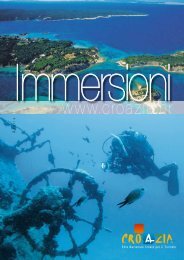Diving
Diving
Diving
Create successful ePaper yourself
Turn your PDF publications into a flip-book with our unique Google optimized e-Paper software.
Varese: a twin-masted Italian merchant ship that was transporting<br />
phosphates on the route from Venice to Tunisia. Launched in 1870 it<br />
perished in January 1915 when, sailing into the port of Pula, its bow<br />
struck an underwater mine, the vessel rapidly sinking. The remains of<br />
the ship lie at a depth of 32 to 41 m on a seabed of ooze, which often<br />
makes for quite poor visibility. Its length was 65 m, and a beam of 8 m. All<br />
that remains is the iron hull, now colonized by shoals of fish, covered by<br />
moss, sponge and other marine creatures, and has become an artificial<br />
reef. The bow has disappeared, destroyed when the mine exploded.<br />
Remains of the front parts of the ship are covered in fishing nets. Still<br />
visible are the opening of the rear cargo hold and the stern.<br />
Hans Schmidt: this wreck was for a long time known as the ISTRA, since<br />
the true name of the vessel was not known. Subsequently, it was discovered<br />
that the ship was built in 1920 in Holland and named Albireo, while the<br />
name it carried when it sank was derived from its final owner in Germany.<br />
There is very little information available regarding its history prior to its<br />
sinking. This 110 m steam-powered cargo ship was ripped in half when it hit<br />
an underwater mine, the explosion made all the more powerful since, on its<br />
final voyage, the vessel was carrying arms and ammunition. It lies at a depth<br />
of 32 to 40 m, and is a site suitable for advanced divers.<br />
The Brijuni National Park is an area under special protection where<br />
diving is allowed only under the auspices of authorized diving centres.<br />
This aquatorium abounds with the extremely attractive flora and fauna<br />
of the Adriatic’s submarine world and it is common to come across<br />
large groupers, corals and sponges of varying colours and shapes. The<br />
Hans Schmidt<br />
seabed around the island is full of crevices in rocks, small caves and<br />
tunnels in the seabed itself, which provide ideal shelter for a wide variety<br />
of fish and other sea creatures.<br />
Fraškerić is a system of tunnels located west of the India auto-camp,<br />
which is located south of Pula. This is a very attractive and popular site<br />
suitable for all categories of divers, but it is nevertheless recommended<br />
that one goes accompanied by a guide from a licensed and authorized<br />
diving centre. Also to be found in this area is an underwater wall which<br />
begins at a depth of 14 m and ends at a depth of 35 m, where there is a<br />
mast from a sailing ship rammed into a crevice in the wall. It is believed<br />
that this mast broke off during a storm, sunk and became stuck in the rock<br />
wall.<br />
Reff Stoja is a very specific geological configuration to the south of Pula:<br />
canyons, crevices and caves full of all kinds of fish provide an excellent<br />
site for underwater filming.<br />
Pula<br />
Valovine is a site ideal for what is known as relaxation diving. It is a<br />
system of caves to the west of Pula, practically adjacent to the coast,<br />
which end in a canyon of up to 20 m in depth. A highly attractive location<br />
for all categories of divers and particularly interesting for underwater<br />
ambiental filming.<br />
Some of these locations are under the special protection of the Ministry<br />
for Culture as protected cultural heritage, and to dive there one must<br />
arrange to be supported by the organization and professional guidance<br />
of licensed diving centres which have been granted official permission to<br />
carry out tourist diving activities in areas under special protection.<br />
In addition to the wrecks of ships, aircraft and submarines, the waters<br />
around Istria teem with submarine life, particularly around underwater<br />
reefs and in and around such wrecks where conger eels and fork beard<br />
are a common sight, and where shoals of smaller fish congregate. On<br />
occasions, and in locations beyond the immediate coastal belt, one can<br />
also see greater amberjack and tuna. Istria, therefore, is not a place<br />
where only lovers of wreck diving come into their own. Rocks, caves,<br />
holes and reefs offer something for divers with different interests, while<br />
locations are suited to all levels of diving skill and certificates. The<br />
underwater flora and fauna of Istria is typical of the wider Adriatic. Shoals<br />
of different types of fish, lobsters, calamari, crabs, seahorses, starfish,<br />
sponges and other attractive species of underwater fauna and flora find<br />
their habitat in these warm and shallow parts of the northern Adriatic.<br />
∆ Clawed lobster (Homarus gammarus) is an<br />
attractive frequenter of the Adriatic Sea<br />
Croatian National Tourist Board<br />
11




